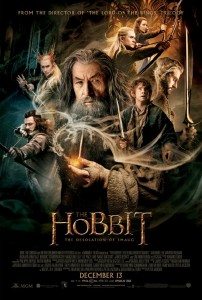
 The original "Lord Of The Rings" trilogy is the undisputed champion of book-to-film adaptations. So fans were more than eager to return to Middle Earth when Peter Jackson decided to return to direct an adaptation of Toklien's prequel, "The Hobbit". But when it was announced that the slim book would be turned into three films, reactions were mixed. Some were perplexed. Where would so much extra material come from? Some were enraged. Wasn't this just a blatant grab for extra cash?
The original "Lord Of The Rings" trilogy is the undisputed champion of book-to-film adaptations. So fans were more than eager to return to Middle Earth when Peter Jackson decided to return to direct an adaptation of Toklien's prequel, "The Hobbit". But when it was announced that the slim book would be turned into three films, reactions were mixed. Some were perplexed. Where would so much extra material come from? Some were enraged. Wasn't this just a blatant grab for extra cash?
It's certain that money was on the studio's mind when the decision was made, but it's equally certain that Peter Jackson is still madly in love with the franchise -- and anyone who's a fan should appreciate the extra time we get to spend in this fantastical realm. Those who were disappointed by the lighter tone of "An Unexpected Journey", filled with dinner parties, pratfalling dwarves, obese goblins and more than one musical number, will be pleased to hear that "The Desolation Of Smaug" is more in line with the tone of the "Rings" films. The action is increased, the stakes are higher, progress is made story-wise, and -- of course -- we finally get to meet Smaug.
The one thing that gets sacrificed in the midst of everything that's bigger and better this time around is focus on the hobbit himself. "Smaug" is much more an ensemble film than "Journey". New additions include Legolas (Orlando Bloom), his father Thranduil (Lee Pace), Elf warrior Tauriel (Evangeline Lilly), reluctant hero Bard (Luke Evans), the conniving Master of Laketown (Stephen Fry), and the dragon Smaug (voiced by Benedict Cumberbatch). With so much to focus on, Bilbo is shifted to the sidelines for much of the film. But in his few standout moments, Martin Freeman is fantastic. Particularly memorable is a scene early on where the Ring exerts an unexpected influence on him, and also his frightened interactions with Smaug.
Many viewers were dismayed to see the heavy reliance on CGI in "Journey", especially in portraying the Orcs pursuing Bilbo and the dwarves. In "Smaug", these effects are vastly improved, and are sometimes intermingled with live actors in prosthetics, à la the "Rings" films. The fight scenes are less cartoonish in this outing as well, aided by some truly spectacular choreography that is both fast-paced and wildly inventive. Where the effects shine through the most are in the design and execution of Smaug. In coming up with the concept for the fearsome beast, Jackson has said that he decided size would be his most impressive feature. And impressive it is -- he is staggeringly huge, especially next to tiny Bilbo. And with the rumbling voice of Cumberbatch, he's a formidable and memorable villain. The final thirty minutes of the film are an edge-of-your-seat thrill ride as Smaug toys with Bilbo and chases him and the dwarves through the mountain.
"Smaug" does occasionally suffer from middle-entry-itis. Containing neither a proper beginning nor a proper ending, it has the potential to feel unfulfilling. But it does advance the plot more than the first entry, especially the scenes with Gandalf (Ian McKellen, fantastic as usual) investigating the rise of the mysterious Necromancer (also voiced by Cumberbatch). These scenes set up what will surely be an epic climax in the final film. With dragons and wizards, meek hobbits and traitorous elves, giant spiders and skinchanging bears, there's a lot to love about "The Desolation Of Smaug". It's not perfect, but it's one hell of a ride -- and all but guarantees next year's "There And Back Again" will be a must-see event.
[youtube]https://www.youtube.com/watch?v=OPVWy1tFXuc&noredirect=1[/youtube]